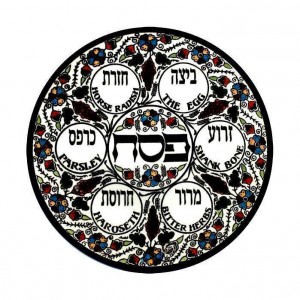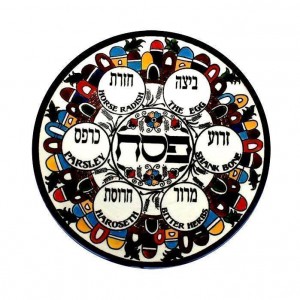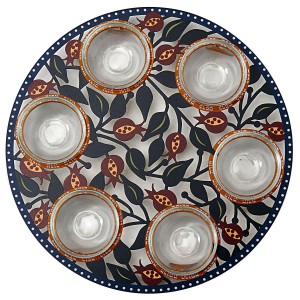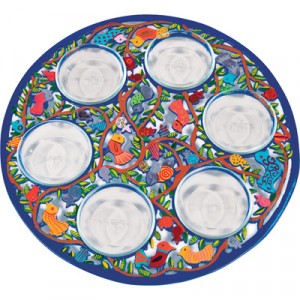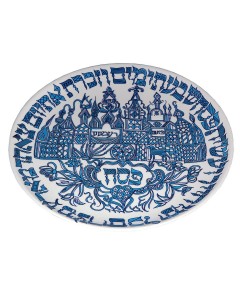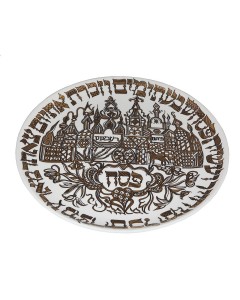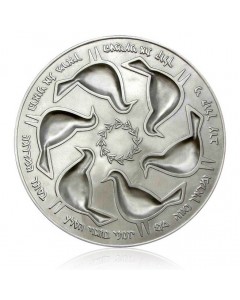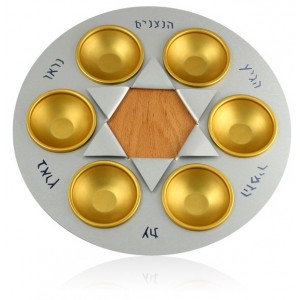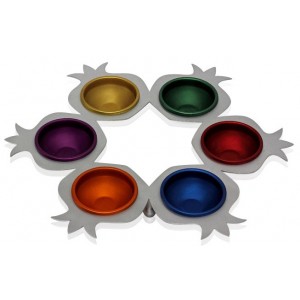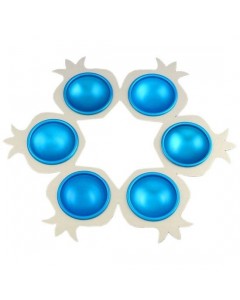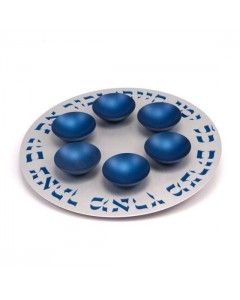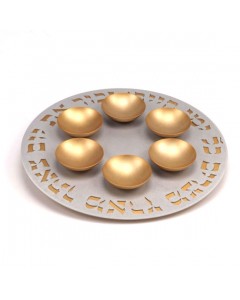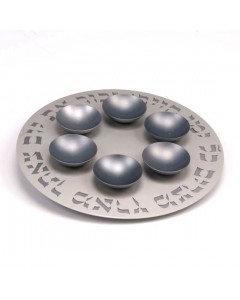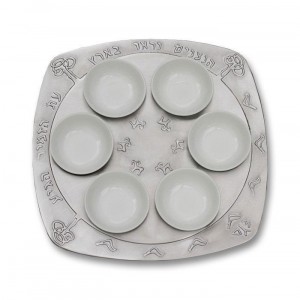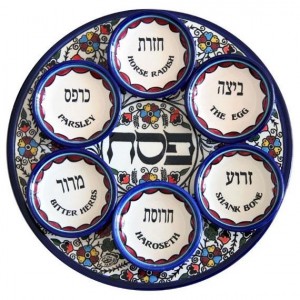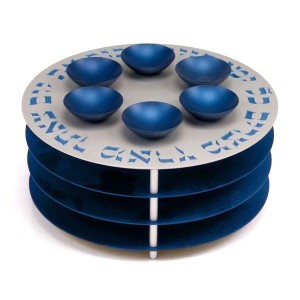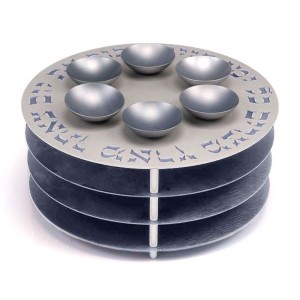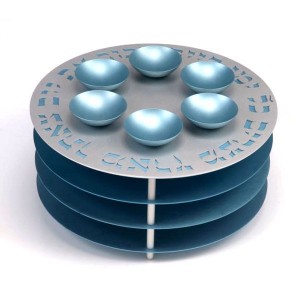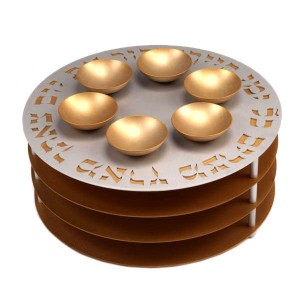The Seder plate, also known as Seder bowl or Passover Seder plate, is at the center
of every Jewish dining-room table during Passover. This is the traditional plate on which
we place six types of foods that represent concepts that relate to Pesach and the Exodus. The Charoset, a sweet mixture of fruits, wine and honey, represents the mortar that the Hebrews used to build cities in Egypt; the maror, bitter herbs, and chazeret, horseradish, symbolize the hardships that the Hebrews underwent; the karpas, any vegetable other than bitter herbs, usually potato or celery, is dipped in salt water and stands for the many tears shed by the enslaved Hebrews; the hard-boiled egg represents the korban hagigah, the festival sacrifice, that was offered in the Temple; finally the z’roa, usually a chicken wing or roasted lamb, represents the korban haPesach, the Passover sacrifice. The z’roa is only symbolic and is not eaten.
Plateaux de Seder
Le plateau de Seder, ou bol du Seder, ou encore assiette du Seder de Pâque, est au centre de toute table juive lors du dîner de Pâque. Il s'agit de l'assiette traditionnelle dans laquelle on place les six types d'aliments qui rappellent des idées liées à Pessah ou à l'exode. Le Haroset, un mélange sucré de fruits, de vin et de miel, représente le mortier que les Hébreux utilisaient pour construire des villes en Egypte; le maror, ou herbes amères et le Hazeret, ou raifort symbolisent les épreuves que les Hébreux ont endurées; le Karpas, tout légume autre que des herbes amères, généralement de la pomme de terre ou du céleri, est trempé dans de l'eau salée et représente toutes les larmes versées par les esclaves Hébreux; l'œuf dur représente le 'Korban Hagiga', le sacrifice de la fête qui était offert au Temple; enfin, le Zroa est un os rappelant le sacrifice de l'agneau pascal à l'époque du Temple. Le zroa n'est que symbolique et n'est pas mangé.
Le plateau de Seder, en plus de jouer un rôle religieux important pour Pâque, possède un rôle esthétique non négligeable: étant la pièce centrale de la table, de nombreux Juifs décident de se procurer des plateaux de Seder relativement chers aux ornements élaborés et élégants. Des ornements de grenades en aluminium à ceux en verre ou en étain, il existe une pléthore de plateaux de Seder de Pessah permettant de trouver le sien.
L'assiette de Seder en céramique a été la plus populaire pendant de nombreuses années. L'une des raisons de son succès peut être la variété possible des designs: on peut trouver des assiettes carrées, circulaires et même en forme de grenade. De plus, l'un des avantages de la céramique est qu'en plus d'utiliser des matériaux divers, tel que l'argent ou la porcelaine, on y observe de nombreuses couleurs; la combinaison du blanc et des couleurs vives rend toujours un merveilleux effet. Une tendance en forte croissance ces derniers temps est le plateau de Seder gravé de citations en hébreu et d'images. Sur ces derniers, vous observerez des figures telles que les douze tribus ou les douze signes astrologiques, aussi bien que les six images des six aliments. Sous chaque image, apparait le nom hébreu et parfois, une petite description de l'image représentée.
Sachant qu'il n'existe pas de règle stricte concernant l'apparence du plateau, les artistes ont une grande marge d'action au moment de créer et décorer les assiettes. Ainsi, vous trouverez des créations de plateau de Seder en forme d'étoile de David par exemple. L'étoile de David est souvent faite d'argent sterling, et entre chacune des deux lignes qui se forment à l'extérieur de l'étoile, apparaissent six petites assiettes pour les six aliments.
Comme de nombreux objets Judaica, certains plateaux de Seder sont fabriqués spécialement pour les enfants. Lorsqu'il y a beaucoup d'enfants à table, un excellent moyen de les occuper est de les regrouper et de placer un plateau de Seder supplémentaire dans leur section. Cette assiette, contrairement à celle des adultes, comportera des motifs enfantins tels que des arbres, des fleurs, des animaux et autres. Au centre de l'assiette, on observe un grand 'Pessah' en hébreu, chaque lettre d'une couleur différente. Le plateau de Seder de Pessah pour les enfants est bien évidemment résistant et ne se casse pas facilement, dans les cas où de jeunes enfants en aient assez de la Haggada et décident qu'il est temps de jouer avec l'assiette.
Pour plus d'informations sur notre site et ses produits, merci de Nous Contacter. Assurez-vous de parcourir notre superbe page d'apprentissage sur Pessah pour plus d'idées sur ce que vous pouvez offrir à vos proches pour Pâque.
Guide pour Plateaux de Seder
Tandis que la plupart des fêtes juives se déroulent traditionnellement à la synagogue, le respect premier de Pâque (ou Pessah, en hébreu) se passe à la maison avec un repas festif et une célébration rituelle appelée 'Seder'. Durant le Seder, chaque participant a l'opportunité d'écouter à nouveau l'histoire de l'exode, ou comment D.ieu a libéré les esclaves israélites de 400 ans de servitude envers le Pharaon d'Egypte. Le livre utilisé pour conduire le Seder est appelé la 'Haggada', et raconte l'histoire de l'exode de telle sorte à pouvoir être apprécié à la fois par les plus jeunes et les plus âgés. De fait, l'histoire démarre avec un enfant, qui pose une question qui semble très simple: 'Pourquoi cette nuit est-elle différente des autres nuits?'
En guise de réponse, l'histoire commence à l'aide de citations de la Torah, de commentaires issus du Talmud, de chansons, de bénédictions, de rituels ainsi que de tous les symboles du Seder, dont la majorité est représentée sur l'assiette du Seder, décoré spécialement pour cette occasion.
Les Symboles du Plat du Seder
Le plateau de Seder contient au moins cinq symboles (et souvent un ou deux de plus).
-
L'œuf dur (ou 'Beitza') est un symbole printanier et de fertilité. Bien qu'il n'ait pas de bénédiction qui lui soit propre lors du Seder, le repas festif débute traditionnellement en mangeant un œuf dur.
-
La Haroset est un mélange qui représente le mortier utilisé par les esclaves israélites lorsqu'ils édifiaient des villes égyptiennes. Chaque famille possède sa propre recette pour le Haroset, et bien sûr, tout le monde a la meilleure recette! Les Juifs de différents pays utilisent différents ingrédients, mais dans de nombreuses traditions, le Haroset se compose de pommes hachées, de noix, d'épices et de vin.
-
Les herbes amères ('Maror'), souvent du raifort, symbolisent l'amertume de l'esclavage. Pendant le Seder, les herbes amères sont souvent trempées dans le Haroset pour atténuer son goût amer.
-
Les légumes verts ('Karpas'), souvent du persil, sont un autre symbole de Pessah comme fête printanière. Pendant le Seder, le Karpas est trempé dans de l'eau salée comme symbole des larmes versées par les esclaves israélites. (Certains plateaux de Seder incluent un creux pour l'eau salée et d'autres non. S'il n'y a pas d'endroit prévu pour cela sur l'assiette du Seder, l'eau salée est placée séparément dans un ou des bol(s) sur la table du Seder).
-
L'os de jarret ('Zroa') symbolise le sacrifice de l'agneau pascal de Pessah, pratique du Judaïsme remontant à l'époque du temple de Jérusalem.
-
Beaucoup d'assiettes de Seder incluent aussi une place pour la laitue ('Hazeret') comme une herbe amère supplémentaire. Certaines traditions incorporent ce symbole, et d'autres non, mais ceux qui le font citent souvent le commande de la Torah de manger le sacrifice de l'agneau pascal avec du pain non levé et des herbes amères (au pluriel), Nombres 9:11.
Plateaux de Seder
Un plateau de Seder est la pièce centrale de toute table de Seder et peut être fait d'argent, de porcelaine, de céramique ou même de verre. Généralement, il comporte des sections séparées pour chacun des symboles de Pessah, avec les noms des symboles peints ou gravés. Certaines personnes utilisent des couvres plateaux de Seder embellis ou brodés afin d'augmenter encore un peu la beauté de leur table. Les assiettes de Seder peuvent être certaines des plus belles pièces d'art judaica disponibles et font souvent partie d'un héritage familial qui se transmet de génération en génération.
Pour Plus d'Informations
Pour plus d'informations sur Pâque, les Plateaux de Seder, ou d'autres articles Judaica, n'hésitez pas à contacter nos experts Judaica pour toutes vos questions.

